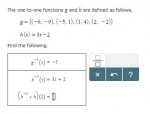
Hello there!
I'm brand new to these forums, and I'm in desperate need of help.
I believe i understand the first two parts of this problem. But i can't for the life of me understand the last part!
Please help! If I've made a mistake with the first two parts, please don't hesitate to correct me.
I'm reviewing for an Exam tomorrow and want to be able to do this type of problem on my own.
Thank you so much!
